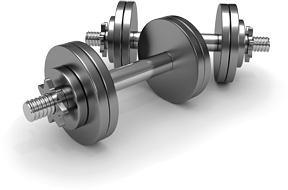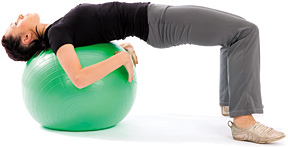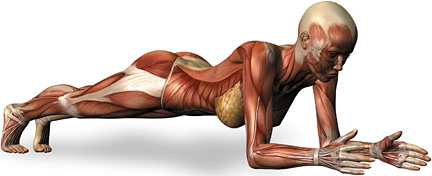This usually occurs automatically with contraction of the trunk (rib cage) muscles and holding your breath. In addition, the spinal (midsection) muscles undergo contraction to stabilize the trunk.
This is one reason why you see the trunk arching during execution of the exercise. Difficult isometric contractions should be held only for 5-6 seconds at a time.
Other Beginning Isometric Exercises to Try
Sustain Plank (isolates chest and core)
Lie on floor and then get into a "plank position: hold a straight body position, supported on elbows and toes.
Brace the abdominals and set the low back in the neutral position.
Keep back flat and cervical spine in neutral; keep body / torso in alignment.
Build up to holding the plank for 1 minute. Perform two reps.
Supine Gut Contractions
Lie on the floor on your back, feet flat on the floor with the knees bent.
Contract the glutes to create a bridge, elevating off the floor.
Maintain the cervical spine in a neutral position. No low back discomfort and no hamstring cramps.
Build up to holding each squeeze from 10 seconds to 60 seconds. Perform five repetitions.
 Upper-Body Arm Hangs
Upper-Body Arm Hangs
Pull yourself up on a chin-up bar while keeping the eyes horizontal to the bar.
Keep hands / wrists in neutral position, elbows at 90 degrees, and avoid body movement (swinging, etc.).
Maintain the position to failure without violating the above rules.
Stability Ball Bridge
 Place your head and upper back on a stability ball, torso in a "table top" pose.
Place your head and upper back on a stability ball, torso in a "table top" pose.
Contract the glutes to create a bridge. The muscles recruited should
be primarily from the glutes (some abdominals and quadriceps.
There should be no low back discomfort and no hamstring cramps.
As you progress you can lift your head off the ball.
Build up to holding each squeeze from 10 seconds to 30 seconds. Perform five reps.
Take the Isometric Challenge
Whatever the isometric exercise, test yourself for the amount of time you can hold a specific position /pose. You can use free weights, kettlebells, weight machines or elastic tubing. For example, hold a kettlebell weight in your hand with the weight at your side. Your objective is to prevent it from going down or shifting your posture. Your intent is not to move the load (i.e., raise or lower it), but to prevent its movement.
Isometric exercises are an important component of a quality workout, particularly when they are combined with plyometric exercises, which, unlike isometrics, rely on short, quick bursts of speed, power and movement (think jumping, hopping, leaping, skipping, etc.). Your doctor can give you more information on isometrics and plyometrics while outlining a safe, effective workout that's tailored to your current fitness level and health needs.

The Advantages of Isometrics
- An injured or immobilized extremity can be tensed while in a cast or in a splint after the immediate pain has subsided.
- Ideal for people with little or no exercise experience.
- Can be used early in a rehabilitation program.
- Great way to teach proper biomechanics.
- Can help prevent muscle and strength losses.
- Achieves maximum muscular contraction and increases strength faster than any other form of training.
- Gain strength in isolated areas or muscle groups without moving the joints.
- May increase muscle size and develop more efficient muscle contractions.
- Works muscle with more intensity in a shorter period of time.
- Prepares the musculoskeletal system for more advanced activities.
- Increases neurological strength, recruits more muscle fibers for each movement.
- Good for enforcing movement patterns (especially in youth).
- Isometric workouts can be fast and done anywhere.
- Safer than conventional training (doesn't involve movement).
- Dramatically improves conventional training; can increase lifts by as much as 14 - 40 percent!
Jeffrey Tucker, DC, is a doctor of chiropractic and rehabilitation specialist who integrates chiropractic, exercise and nutrition into his practice in West Los Angeles. You can sign up for his newsletter at DrJeffreyTucker.com.

